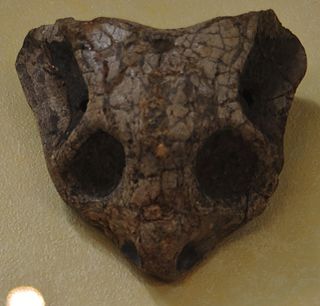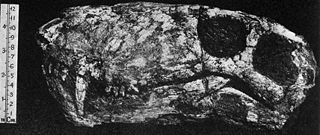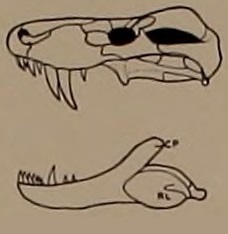
Youngina is an extinct genus of diapsid reptile from the Late Permian Beaufort Group of the Karoo Red Beds of South Africa. This, and a few related forms, make up the family Younginidae, within the Order Eosuchia. Eosuchia, having become a wastebasket taxon for many probably distantly-related primitive diapsid reptiles ranging from the Late Carboniferous to the Eocene, Romer proposed that it be replaced by Younginiformes.

Cistecephalus is an extinct genus of dicynodont therapsid from the Late Permian of southern Africa. It was a small, specialised, burrowing dicynodont, possibly with habits similar to a modern mole. The head was flattened and wedge-shaped, the body long, and the forelimbs very strong, with similarities in structure to the forelimb of modern burrowing mammals.

Gyposaurus is a genus of basal sauropodomorph dinosaur from the early Jurassic of South Africa. It is usually considered to represent juveniles of other prosauropods, but "G." sinensis is regarded as a possibly valid species.

Gorgonops is an extinct genus of gorgonopsian therapsids, of which it is the type genus, having lived during the Late Permian (Wuchiapingian), about 260–254 million years ago in what is now South Africa.

Geranosaurus is a genus of ornithischian dinosaur from the Early Jurassic. It is known only from crushed fragments of the skull, a single jaw bone with nine tooth stubs and limb elements discovered in the Clarens Formation, South Africa in 1871. Because of the limited remains, it is considered a nomen dubium. It is classified as an ornithischian based on the jaw, probably a heterodontosaurid. It was around 0.6 metres (2.0 ft) tall and around 1.2 metres (3.9 ft) long when fully grown.

Procynosuchus is an extinct genus of cynodonts from the Late Permian. It is considered to be one of the earliest and most basal cynodonts. It was 60 cm (2 ft) long.

Lycaenops ("wolf-face") is a genus of carnivorous therapsids. It lived during the Middle Permian to the early Late Permian, about 260 mya, in what is now South Africa.

Emydops is an extinct genus of dicynodont therapsid from the Permian of South Africa. Emydops was first named by South African paleontologist Robert Broom in 1912 when he described Emydops minor. In the following years, the genus grew to include thirteen species. Many of these species were erected on the basis of differences in the teeth and the positioning of the frontal and parietal bones. A 2008 study narrowed Emydops down to two species, E. arctatus and the newly described E. oweni.

Trochosaurus is an extinct genus of South African therocephalians. In 1915 and later, some of its member species were first described by Robert Broom as Trochosuchus spp. and later reassigned to the new genus. The genus includes some of the most primitive known Therocephalia.

Aelurognathus is an extinct genus of gorgonopsian therapsids from the Permian of South Africa.

Aloposaurus is an extinct genus of gorgonopsian therapsids from the Late Permian of South Africa. It was first named by Robert Broom in 1910, and contains the type species A. gracilis, and possibly a second species A. tenuis. This small gorgonopsid had a slender narrow skull only 12 centimetres (4.7 in) long, with a total body length of 60–70 cm (2.0–2.3 ft).

Aelurosaurus is a small, carnivorous, extinct genus of gorgonopsian therapsids from the Middle Permian to Late Permian of South Africa. It was discovered in the Karoo Basin of South Africa, and first named by Richard Owen in 1881. It was named so because it appeared to be an ancestor for cat-like marsupials, but not yet a mammal itself. It contains five species, A. felinus, A. whaitsi, A. polyodon, A. wilmanae, and A.? watermeyeri. A. felinus, the type species, is generally well described with established features, while the other four species are not due to their poorly preserved holotypes.

Lydekkerina is an extinct genus of stereospondyl temnospondyl. It is the type genus of the family Lydekkerinidae. Fossils have been collected from Early Triassic deposits in South Africa and Australia. The type species is L. huxleyi, first described in 1889. While most other stereospondyls were semiaquatic, Lydekkerina was exclusively terrestrial.
Howesia is an extinct genus of basal rhynchosaur from early Middle Triassic deposits of Eastern Cape, South Africa. It is known from the holotype SAM 5884, a partial skeleton with palate and partial lower jaws and from two paratypes, SAM 5885 and SAM 5886. It was found in the Burgersdorp Formation of the middle deposits of the Beaufort Group and referred to Subzone B of the Cynognathus Assemblage Zone. It was first named by Robert Broom in 1905 and the type species is Howesia browni, named after Alfred Brown.
Ictidodon is an extinct genus of therocephalian therapsids from the Late Permian of South Africa. The type species Ictidodon agilis was named by South African paleontologist Robert Broom in 1925. Broom classified Ictidodon in the Scaloposauridae, a group of small-bodied therocephalians that are now thought to be juvenile forms of larger therocephalians. Ictidodon and many other scaloposaurids are now classified as basal members of the clade Baurioidea.
Ictidodraco is an extinct genus of therocephalian therapsids from the Late Permian of South Africa. The type species Ictidodraco longiceps was named by South African paleontologists Robert Broom and John T. Robinson in 1948 from the Cistecephalus Assemblage Zone. Ictidodraco was once classified as a scaloposaurian in the family Silpholestidae. Scaloposauria and Silpholestidae are no longer regarded as valid groups, and Ictidodraco is now classified as a basal member of the clade Baurioidea.
Polycynodon is an extinct genus of therocephalians from the Late Permian of South Africa. It is known from the Cistecephalus Assemblage Zone. The type species was first described as Octocynodon elegans by South African paleontologist Robert Broom in 1940, but the name Octocynodon was preoccupied by a genus of labrid fish first described in 1904. Along with John T. Robinson, Broom instated Polycynodon as a replacement name for O. elegans in 1948. Polycynodon is classified in Baurioidea, although its relationship to other baurioid therocephalians is uncertain.
Simorhinella is an extinct genus of therocephalian therapsids from the Late Permian of South Africa. It is known from a single species, Simorhinella baini, named by South African paleontologist Robert Broom in 1915. Broom named it on the basis of a single fossil collected by the British Museum of Natural History in 1878 that included the skull and jaws forward from the eye sockets. The skull is unusual in that it has an extremely short and deep snout, unlike the longer and lower snouts of most other therocephalians. Because of the skull's distinctiveness, the classification of Simorhinella within Therocephalia is uncertain. However, a 2014 study proposed that it was closely related to the basal therocephalian Lycosuchus, placing it in the family Lycosuchidae.

Cynariops is an extinct genus of gorgonopsian that lived in what is now South Africa during the Permian. The holotype skull specimen MB.R.999 was made the basis of the new genus and species Cynariops robustus by Robert Broom in 1925, but the genus was later synonymised with other genera. It was catalogued as a specimen of Aelurognathus at Museum für Naturkunde, Berlin, until it was further prepared and described in 2018, and the genus Cynariops resurrected.
Anningia is an extinct genus in Varanopidae, a family of monitor lizard-like amniotes. It contains a single species, Anningia megalops.














